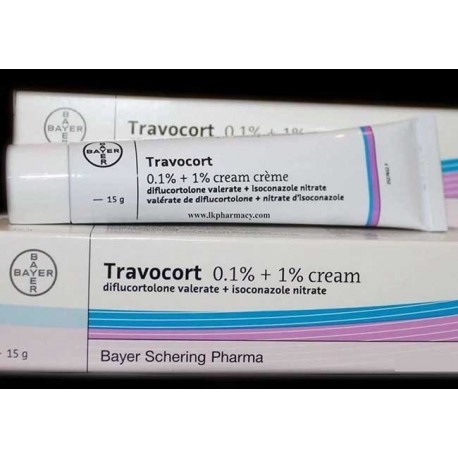 View larger
View larger Volume discounts
| Quantity | Discount | You Save |
|---|---|---|
| 2 | 5% | Up to $3.60 |
| 3 | 10% | Up to $10.80 |
| 4 | 15% | Up to $21.60 |
| 5 | 20% | Up to $36.00 |
More info
TRAVOCORT cream 15g It is applied externally.
Active ingredient
1 g of TRAVOCORT contains 10 mg (1%) isoconazole nitrate and 1 mg (0.1%) diflucortolone valerate.
Excipients
Polyethyleneglycol-Sorbitan stearate, sorbitan stearate, cetostearyl alcohol, white petrolatum, thick paraffin, disodium edetate, demineralized water
1. What TRAVOCORT is and what it is used for
TRAVOCORT is used for the initial or intermediate treatment of superficial fungal infections of the skin, accompanied by severe inflammation or eczema (for example, in the hands, between the fingers, in the groin and genital areas).
The package size of TRAVOCORT is 15g and 1g of TRAVOCORT contains 10 mg (1%) isoconazole nitrate and 1 mg (0.1%) diflucortolone valerate active ingredients.
Isoconazole nitrate; It is used for the treatment of superficial fungal diseases of the skin. It is effective against many microbes; It is also effective against dermophytes, yeasts, yeast-like fungi (including organisms that cause pityriasis versicolor), molds, as well as organisms that cause Erythrasma, an infectious skin disease characterized by red, brown spots.
Diflucortolan valerate; It prevents inflammation in inflammatory and allergic conditions of the skin and relieves complaints such as itching, burning and pain.
2.How to use TRAVOCORT?
Instructions for proper use and dose/frequency of administration
You should always use TRAVOCORT exactly as your doctor has told you. If you are not sure, ask your doctor or pharmacist again.
TRAVOCORT is applied twice a day.
In coordination with your doctor, TRAVOCORT treatment should be terminated no later than 2 weeks after healing of the inflammatory or eczema skin. After that, your doctor may continue treatment with TRAVOGEN, a corticosteroid-free cream. This is especially true for use in the groin and genital areas.
Application route and method
Apply externally to the diseased skin area.
different age groups
Use in children
It should be used with caution in children due to the risk of increased systemic absorption and side effects.
Special use cases
Use in the elderly
If you have the impression that the effect of TRAVOCORT is too strong or too weak, talk to your doctor or pharmacist.
If you use more TRAVOCORT than you should
If you have used more than you should use from TRAVOCORT, do not worry, talk to a doctor or pharmacist.
No risk is expected after a one-time overdose (1 application to a large skin area) or accidental ingestion of TRAVOCORT.
If you forget to use TRAVOCORT
Your doctor will decide when to administer the missed dose. It is important to follow your doctor's instructions for the new administration time of the next dose.
3. What are the possible side effects?
Like all medicines, there may be side effects in people who are sensitive to the substances contained in TRAVOCORT.
Tell your doctor if you notice any of the following side effects:
The following side effects may occur as a result of applying externally used preparations containing corticosteroids to a large area (approximately 10% or more) or long-term use (over 4 weeks): thinning of the skin (atrophy), enlargement of capillaries, striping of the skin, acne-like changes in the skin, and systemic effects due to resorption of corticosteroid.
Immune system disorders:
Rare: Allergic contact dermatitis. Skin and subcutaneous disorders:
Rare: Inflammation of hair follicles (folliculitis), excessive hair growth on the skin (hypertrichosis), inflammation of the skin around the mouth (perioral dermatitis), skin discoloration, rash, itching, burning, redness (erythema) or formation of inflamed vesicles on the skin (vesiculation). local symptoms, irritation, dryness, skin softening (maceration), rash
These are mild and usually temporary side effects from the use of topical corticosteroids; It was observed that the complaints disappeared with the continuation of the treatment. Local effects such as itching or burning may occur in approximately 1% of patients following topical treatment.
Local irritation and burning occurred in 0.5% to 4% of patients receiving topical treatment with diflucortolone valerate.
Side effects can be seen in babies of mothers during pregnancy and breastfeeding period or when used on large body surfaces or for a long time. For example, when Travocort is administered in the last weeks of pregnancy, regression of the adrenal gland may be seen in the baby.

